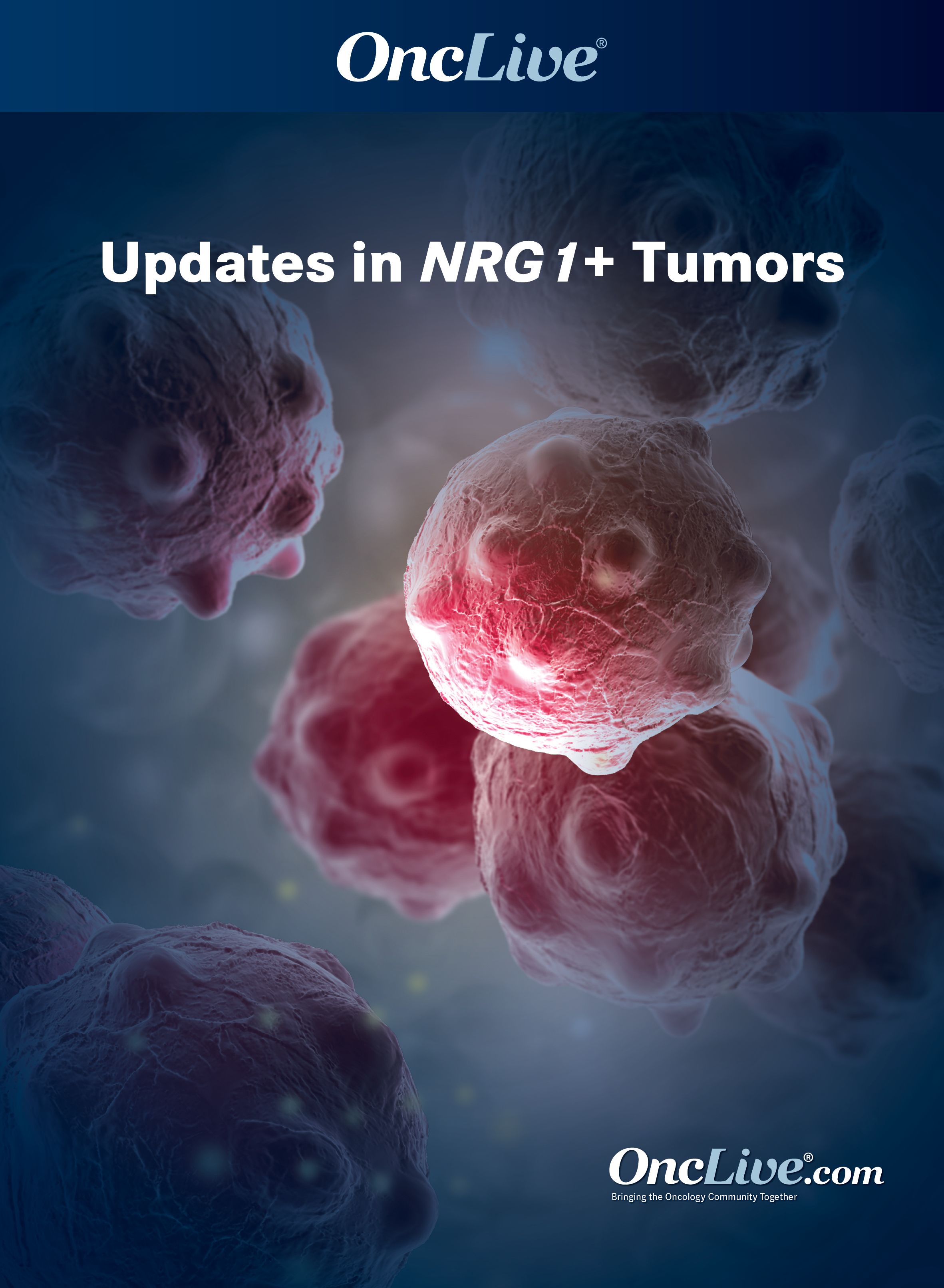Publication
Article
Supplements and Featured Publications
Seribantumab Demonstrates Positive Response Rates, Tolerability in NRG1 Fusion+ Solid Tumors
Author(s):
Daniel R. Carrizosa, MD, MS, discusses the design and important efficacy and safety findings from CRESTONE trial evaluating seribantumab and the importance of finding a targeted therapy for patients with solid tumors harboring NRG1 fusions.
Daniel R. Carrizosa, MD, MS

Seribantumab, a HER3-directed monoclonal antibody, has elicited strong response rates with minimal and mild adverse effects (AEs) in adult patients with NRG1 fusion–positive solid tumors, representing a potentially favorable alternative to standard chemotherapy, explained Daniel R. Carrizosa, MD, MS.
Preliminary data from the phase 2 CRESTONE trial (NCT04383210) showed an investigator-assessed overall response rate (ORR) of 33% in cohort 1 (n = 15), which consisted of patients with NRG1 fusions who had no additional oncogenic alterations and no prior treatment with HER-directed therapy. Additionally, the majority of treatment-related AEs in the safety population (n = 35) were grade 1 or 2, most often diarrhea (38%), fatigue (28%), and rash (26%).1
“Seribantumab looks to be safe and manageable,” Carrizosa said. “Low toxicity data show that this may be a drug that could provide patients with a new treatment that is both effective and tolerable to help them live longer.”
In an interview with OncLive®, Carrizosa, an associate professor and leader of the Clinical and Research Program for Head and Neck Cancer at Levine Cancer Institute, Atrium Health, discussed the design and important efficacy and safety findings from CRESTONE. He also explained the importance of finding a targeted therapy for patients with solid tumors harboring NRG1 fusions and outlined why seribantumab could be approved as a novel treatment strategy in this population.
OncLive®: What background information is important to know about NRG1 gene fusions, and what is the practice for detecting these fusions in patients?
Carrizosa: NRG1 is the primary ligand for the HER3 receptor. NRG1 fuses with a partner gene, and then this fusion can then bind to and activate HER2 and HER3 leading to downstream signaling causing tumorigenesis.
NRG1 fusions are quite rare. They occur in about 0.2% of all solid tumors, but they’ve been found in at least 10 different solid tumor types. The 2 most common [tumor types where these fusions are found] are KRAS wild-type pancreatic adenocarcinoma and non–small cell lung cancer, specifically mucinous adenocarcinoma.
How do NRG1 fusions affect outcomes and prognoses?
[The eNRGy1 Global Multicenter Registry] study primarily looked at patients with lung cancer who had NRG1 fusions. That study showed that these patients seemed to not respond as well to therapy as other patients did. They had poor outcomes with both chemotherapy and immunotherapy, thus making us want to find a more targeted therapy to hopefully provide them [with the opportunity for] better responses.
Investigators are exploring seribantumab to potentially target NRG1 fusions. What is the mechanism of action for this agent and what makes it unique?
Seribantumab is a fully human IgG2 monoclonal antibody that’s directed against HER3. It competitively binds against HER3, blocking its dimerization and preventing it from activating, thus preventing that pathway from moving forward and causing tumorigenesis.
This agent is unique in the way that it does this. Other agents that are currently being studied have a slightly different mechanism, as they require binding to more than 1 HER agent, typically HER2 and HER3. We don’t know if that makes a difference, and studies are ongoing. In the future, we’ll know whether binding to HER3 or binding to mutual HER2 and HER3 is a [more effective mechanism].
What inspired the launch of the CRESTONE study, and what are the key objectives of this research?
The eNRGy1 study showed that patients who have NRG1 fusions don’t respond as well to therapy. Therefore, [effective therapies are a] great unmet need in this population. We’re constantly trying to find better targeted therapies that promote better responses and cause fewer AEs than traditional chemotherapy. Seribantumab is providing that novel treatment strategy, and hopefully it will become a standard therapy.
CRESTONE is a global, multi-site study looking at seribantumab in patients with solid tumors with NRG1 fusions. [All eligible patients] must have been previously treated with another therapy. The primary objective of this study is an independent centralized review of ORR. The study also has secondary objectives looking at investigator-assessed ORR, progression-free survival, overall survival, efficacy, and safety. Hopefully, CRESTONE can answer all the questions we have about whether seribantumab can be the future targeted therapy for these patients.
What does the patient population for CRESTONE and what methodologies are you using in the trial?
The study is looking at patients with NRG1 fusion–positive solid tumors. All patients must be adults and they can have any type of solid tumor, it doesn’t have to be a specific type. All patients must have been treated with some other therapy prior to enrolling in the study, and their NRG1 fusion needs to be found locally. After the patients are enrolled, they’ll have their NRG1 fusions centrally confirmed.
The study [treats eligible patients] with intravenous seribantumab weekly, until either [disease] progression or intolerable AEs. CRESTONE has 3 different arms. One arm is looking at patients who just have NRG1 fusions and no other oncogenic alterations, and who have not been treated with any other type of HER-directed therapy. The other 2 arms are more exploratory. The second arm is looking at patients who have been treated with a different type of HER2-directed agent before enrolling in the study. The third arm is looking at patients who have both NRG1 fusions and other oncogenic genomic alterations, or who have specific types of NRG1 fusions that have a different appearance or don’t have an EGF-like domain.
What were the efficacy findings reported the 2022 ASCO Annual Meeting?
At ASCO, we reported that in CRESTONE, seribantumab had good efficacy and safety. By April 2022, we had 12 evaluable patients [in cohort 1]. [In cohort 1,] the investigator-assessed ORR was 33%, and the disease control rate was 92%. Most of these patients were patients with lung cancer, and in these patients, the [investigator-assessed] ORR was slightly better, at 36%. Importantly, there were 2 partial responses, and even more importantly, 2 complete responses. These data showed that seribantumab seemed to work on its target, and patients seemed to respond well with deep responses.
Could you expand on the importance of the findings observed in patients irrespective of fusion partners?
We saw that those 12 patients all had slightly different fusion partners. We couldn’t find a specific association between 1 fusion partner and the drug’s efficacy. That’s important because we want to have a drug that can target many different fusion partners. [If we don’t limit our research to] specific different types, we may find a treatment that is available for many more patients. The study is still early and ongoing, so we’ll need further data to corroborate these results. [Additionally,] new fusion partners could pop up, [and those patients] may not respond as well. We’ll be looking at that in the future.
What did you find as far as safety?
In CRESTONE, seribantumab was effective, but it’s important to us that it’s also safe and well tolerated. At the time of data cutoff, we saw few major AEs in the 35 patients enrolled. Most of these AEs were mild, grade 1 or grade 2. Diarrhea, fatigue, and rash were the most common.
More importantly, there were no drug-related deaths, and no patient stopped receiving the drug because of toxicity. Patients were able to stay on the drug and tolerate it well. We know that diarrhea, fatigue, and rash are quite common AEs that we see with many different drugs, and most oncologists can treat them fairly well.
What are the next steps for further exploration of this agent?
The most important thing is continued enrollment of patients. CRESTONE is trying to get at least 55 patients enrolled in the first cohort, as [those data are] what will potentially get seribantumab registered with different agencies for its approval, so we can treat patients with it. [Continued enrollment] will allow more data so that we can make sure the drug is effective and confirm the safety results that we’ve been seeing, so that we can hopefully provide this new treatment to patients so they can do better and live longer.
If data with seribantumab continue to be positive, how could that change treatment for patients with NRG1 fusions?
If the data continue to show what they’ve been showing, then seribantumab will hopefully be approved and provide a new therapy for patients harboring NRG1 fusions. [This agent could give] them new treatment options for a disease that may not respond as well to what we currently have, hopefully providing them with new hope for the control of their disease.
What do these data mean in terms of genetic testing?
Oncology is moving toward more standardization of next-generation sequencing [NGS] for our patients, so we can find new druggable targets, such as NRG1 fusion proteins. [The CRESTONE data] help confirm the need to do NGS in patients. Particularly, they emphasize the need to choose a comprehensive NGS panel that provides RNA-based sequencing, so we can find fusions like NRG1 and other mutations like NTRK that we also are looking for in cancers.
What main message would you like to leave with colleagues regarding the CRESTONE trial?
CRESTONE provided exciting data showing that seribantumab is a potentially new therapy for patients with NRG1 fusions, as it is an effective drug with a high disease control rate of about 92%. [We also saw] the first reported complete responses in patients with NRG1 fusions.
Seribantumab is also quite safe. Very few major AEs [were reported], and most of them were grade 1 or grade 2 and very treatable. There were no drug-related deaths.
What other research efforts are under way in this population that you’d like to highlight?
The NRG1 fusion population is still a rare population. We’re trying to find the perfect therapy for patients and have that personalized medicine. The most important thing right now is trying to enroll patients in studies such as CRESTONE, so we can find new therapies. Then, we can try to move these therapies into different lines, or even combine them with other agents, as we do in many other areas of oncology.
First, we need to find the patients. Second, we need to treat them well. Third, hopefully we can find even better ways to make them live longer, feel better, and have more hope.
Reference
Carrizosa DR, Burkard ME, Elamin YY, et al. CRESTONE: initial efficacy and safety of seribantumab in solid tumors harboring NRG1 fusions. J Clin Oncol. 2022;40(suppl 16):3006. doi: 10.1200/JCO.2022.40.16_suppl.3006



























%20(2)%201-Recovered-Recovered-Recovered-Recovered-Recovered-Recovered-Recovered-Recovered-Recovered-Recovered-Recovered-Recovered-Recovered-Recovered-Recovered-Recovered-Recovered.jpg?fit=crop&auto=format)
%20(2)%201-Recovered-Recovered-Recovered-Recovered-Recovered-Recovered-Recovered-Recovered-Recovered-Recovered-Recovered-Recovered-Recovered-Recovered-Recovered-Recovered-Recovered.jpg?fit=crop&auto=format)
